According to Amputee Coalition, in the United States alone, nearly two million people are living with limb loss. Approximately 185,000 amputations occur in the US each year due to causes varying from vascular disease to trauma. What’s more, prosthetics can cost anywhere from $5,000 to upwards of $50,000.
Prosthetics become even more expensive when taking into account that they’re best when custom fit, making production slow and costly. This is where 3D printing has proven to be an incredible alternative for producing prosthetics, being an affordable manufacturing technique that can work with many different materials and offer easy customization.
Nowadays, many companies are placing their bets on 3D printed prosthetics and working to make them accessible to everyone who needs them. Even home 3D printers are much more affordable than a traditional prosthetic limb, and you can find DIY prosthetics that are free to print yourself.
In this article, we’ll highlight the most promising and successful 3D printed prosthetics out there. Read on and be amazed!
Legs
Amputations bring major changes to a person’s life, and the process can be a difficult transition. With modern prosthetics, some can regain mobility and their freedom of movement.
There are prosthetics for below-the-knee amputations and transfemoral amputations, with the former being the most developed in terms of 3D printing. There are even some prosthetics that come with microprocessors to help improve mobility!
Unyq Cover
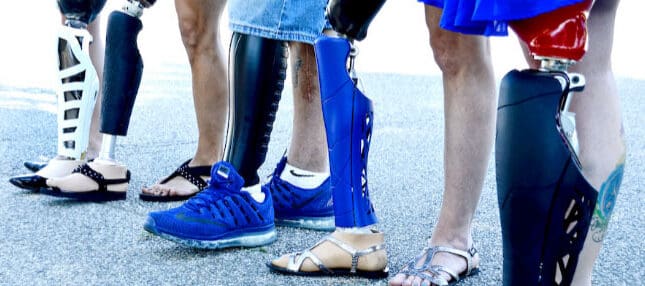
Unyq is a pioneering prosthetics company that began making leg covers for prosthetics. Their stated goal was to have prosthetics become more normalized and prove that they can show personality and uniqueness.
Using 3D printing and photogrammetry to create custom prosthetic covers, Unyq has started producing 3D printed prosthetic leg sockets.
These lightweight and aesthetically appealing sockets also contain sensors that record the health data of the wearer. As a major milestone, they’ve been approved in line with ISO standards.
CRE-004 Prosthesis

This 3D printed prosthetic leg was developed by Agung Dwi Junianto, a teacher from the Sepuluh Nopember Institute of Technology in Indonesia. In collaboration with Djoko Kuswanto from M. Biotech, it’s available for download on Thingiverse.
All files are available in both STL and STEP format for customization. It’s recommended to 3D print the parts in ABS. Aside from that, you’ll need some aluminum parts to complete the prosthesis.
This project has eight shared makes and three remixes, all of which look successful. Many people in different parts of the world have shown their desire to participate in printing this project, and have added remixes with custom sizes for themselves or others.
- Materials: ABS, TPU, PLA, nylon
- Printing technology: FDM
- Designed by: Agung Dwi Junianto and Djoko Kuswanto
- Cost: Free
Feet
The most common use of a prosthetic foot is to allow the wearer to walk. However, there are also people who wear prosthetic feet for cosmetic reasons. Traditionally, there are two types of prosthetic feet: solid ankle cushioned heel (SACH) or elastic keel configurations.
The challenge for 3D printing is to achieve the same level of comfort and mobility that’s possible with traditional materials such as neoprene or urethane foam.
Upya

Upya, which means “new beginning” in Swahili, is a 3D printed prosthetic foot that aims to make prosthetics more accessible in developing countries. The parts are adaptable to each wearer and made for quick and easy assembly.
This model uses biomimicry to achieve a walking sensation close to reality. Its form is supposed to mimic the actual anatomy of the ankle, heel, and toes, and uses a cushioning system of springs to simulate the tendons of the human foot. People who have tested these prosthetics say that it’s the closest they’ve felt to walking since losing their foot.
- Materials: Fiberglass, reinforced polyamide, expanded polyurethane, aluminum
- Printing technology: SLS
- Designed by: Exoneo
- Cost: Contact for estimate
Low-Cost

This low-cost model is the result of an academic study on prostheses by Jonathan Yap and Gianni Renda at the Swinburne University of Technology in Melbourne, Australia. The research focuses on the potential of 3D printing in prosthetics, using a case study of a prosthetic foot designed and produced by the researchers.
Prototyping was done using PLA with a hobby-level printer, the MakerBot Replicator 2. The researchers were able to show that an approximately $11 3D printed prosthetic foot has an even better performance than the most common SACH-style prosthetic.
- Material: PLA
- Printing technology: FDM
- Designed by: Swinburne University of Technology
- Cost: ~$11
Make3D

Make3D is a prosthetics initiative located in The Gambia, West Africa, that’s carrying out important work in making 3D printed prosthetics and other technologies available in African countries. They have partnerships with Prusa Research and many governmental organizations across Europe that support their projects.
Even though we’ve placed them in the category of prosthetic feet, their work isn’t limited to one specific area, and functions in a more case-by-case manner providing solutions to whoever needs them. That said, some of their more prominent work focuses on legs and feet, and they have a Printables page where you can access their feet models for free.
- Materials: PLA, Filatech FilaFlex 40, Filamentum Flexfill 98A, and Prusament PC blend
- Printing technology: FDM
- Designed by: Make3D
- Cost: Files are free, custom designs require an application process
Arms
Prosthetic arms refer to the combination of arm, forearm, and hand prosthetics for those who’ve lost all or part of their arm. There are many types, and they are some of the most complex prosthetics out there due to the precision of movement they require. As such, there’s still a long road ahead in their development and refinement.
According to Arm Dynamics, there are three main types of arm prosthesis: passive, body-powered, and myoelectric upper limb. Passive arm prosthetics are made of silicon and painted to match the wearer’s skin color. These are available in only one position or with joints that the user can accommodate with their other hand to allow different fixed positions.
Then, there are body-powered ones with specific geometry depending on their use (grabbing, pointing, or pushing, for example). These are often made of aluminum, titanium, or steel. Finally, myoelectric upper-limb prosthetics use electrical signals from the muscle in the residual limb to send instructions to the prosthetic arm and hand to achieve functional movement.
Out of the previously mentioned types, the myoelectric prosthesis is the one 3D printing has been helping to greatly advance and make accessible for all who need it.
Hero

The Hero Arm is “the world’s first clinically-approved 3D printed bionic arm, with multi-grip functionality and empowering aesthetics”. Since it’s 3D printed, the Hero is a more affordable option with myoelectric functionality.
Available in different designs inspired by Iron Man, Star Wars, and Frozen, to name a few, these arms can provide confidence and show off the personality of the wearer. What’s more, they have many functionalities such as grab, pinch, high five, and thumbs up.
If you want to read some inspiring stories about Hero Arm wearers, check out their Bionic Squad page!
- Material: Nylon 12 (previously PLA)
- Printing technology: SLS (previously FDM)
- Designed by: Open Bionics
- Cost: $600-$2,000 for covers, contact for prosthetics pricing
Halo

Limbitless is a company that creates bionic arms for children with upper limb loss. In collaboration with 343 Industries, creators of the video game Halo, they created Halo Sleeves in 2019.
The Halo Arm is available in two iterations based on characters in the game. It’s fully functional and capable of gripping objects as well as making many gestures. Note that the Halo Arm is fitted for below-the-elbow amputees, as there’s more access to the nerves that control the movement of the hand.
- Materials: PLA, resin
- Printing technology: FDM, SLA
- Designed by: Limbitless
- Cost: Free (donated)
Unlimbited Arm

The Unlimbited Arm by Team Unlimbited aims to help make complex upper arm prosthetics more accessible and less stigmatized.
This is essentially an arm coupling for kids who have lost their arm or forearm. You can also attach a prosthetic hand to the arm, as these arms are specifically compatible with E-Nable’s Phoenix hand. Thanks to 3D printing, they can also be fun for the kids who need them, as they’re available in many colors and are highly customizable.
- Materials: ABS, PLA, nylon
- Printing technology: FDM
- Designed by: Team Unlimbited
- Cost: Files are free, production is ~$30
Hands
Prosthetic hands are made for loss of limb starting at the wrist. As such, these prosthetics focus on developing movable fingers. Prosthetic hands are complex devices that do more than allow grip. They need to be lightweight, functional, and durable.
The most common material for prosthetic hands is plastic, traditionally achieved by injection molding because it can guarantee all of the previous requirements. Now, 3D printing is emerging as an alternative.
Phoenix Hand v3
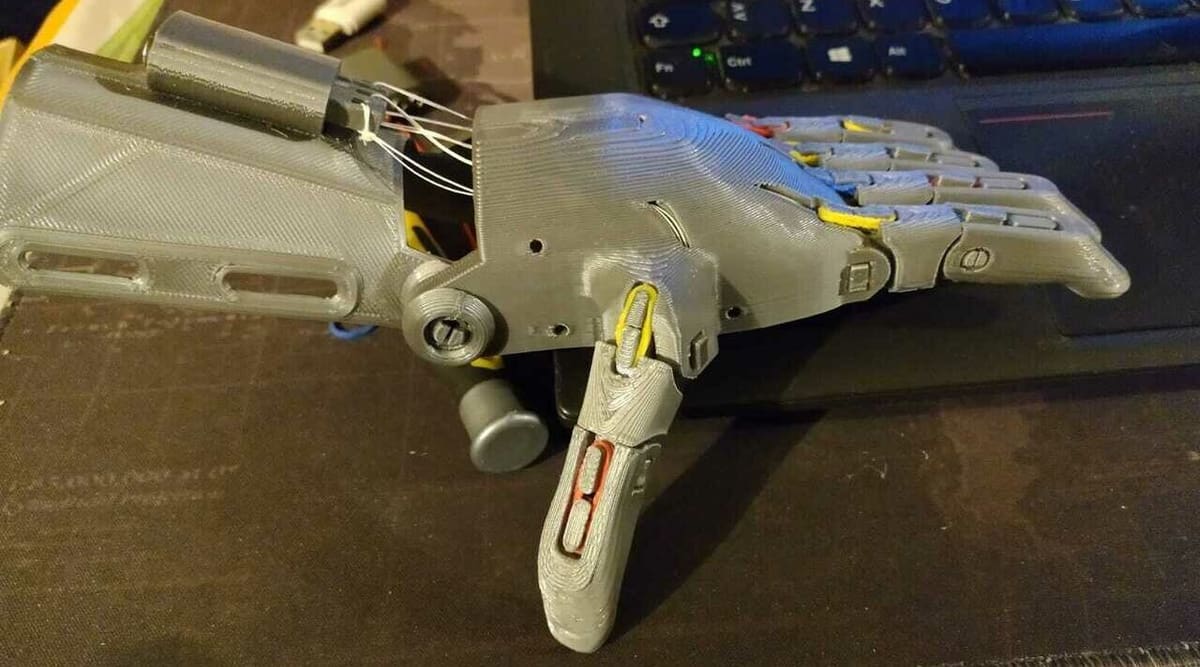
The Phoenix Hand is a wrist-powered device developed by the E-Nable community that adds a palm and fingers to a functioning wrist. To use the fingers of the hand, the user must have enough natural palm to push on the device; this pushing motion will close the fingers.
Since the hand is 3D printed, it can be fitted to any size wrist. The designers state that at 100% scale, the hand would fit a very small child and should be scaled up to fit most use cases.
All STL files, as well as assembly diagrams and videos, are open source and can be found on the design’s Thingiverse page, while the hardware can be purchased separately. At time of writing, the latest version of the model is the Phoenix Hand v3.
- Materials: PETG
- Printing technology: FDM
- Designed by: Jason Bryant, John Diamond, Scott Darrow, Andreas Bastian, Team Unlimbited, E-Nable France, and Jeremy Simon
- Cost: Files are free; the assembly materials kit sells for about $30 on 3D Universe
Kinetic
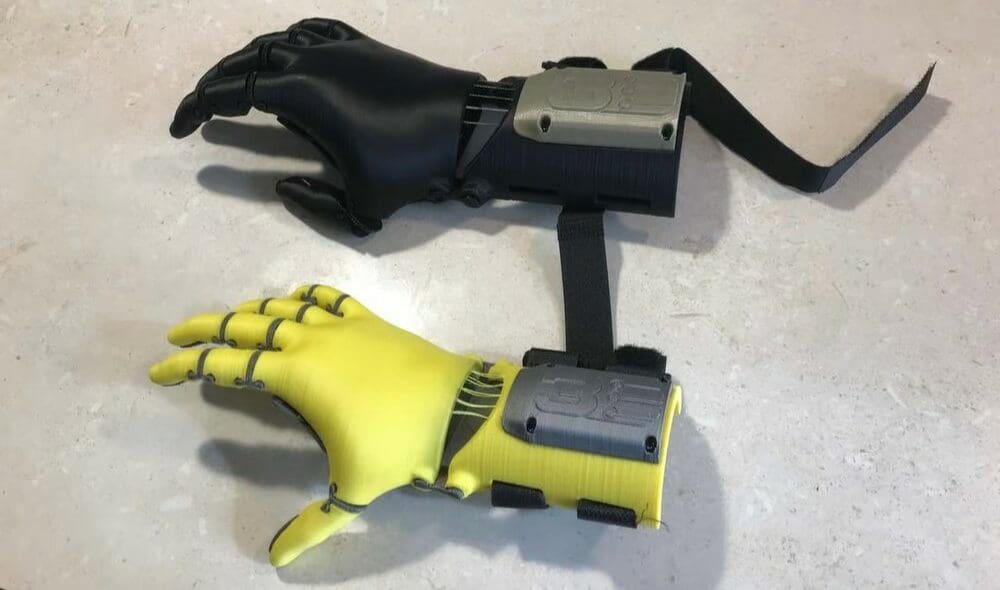
The Kinetic Hand was created by Mat Bowtell and his team at Free 3D Hands, who are part of the E-Nable community. It’s been in development since 2017 and has gone through many changes and improvements.
This is a body-powered device designed to be used by people with functioning wrists. The newest version of the hand is completely free to download on Thingiverse. Feedback is actively encouraged as they continue to develop and improve their hand.
It’s important to note that this hand isn’t designed to sustain heavyweight activities. It should only be used for light tasks such as picking up and handling small objects. Among its advantages are silent operation, flexible hinges, and partial thumb function.
- Materials: PLA+/PLA, NinjaFlex, molded silicone
- Printing technology: FDM
- Designed by: Mat Bowtell and Free 3D Hands
- Cost: Free
Other
The world of orthopedic and reconstructive medicine is vast, even more so when combined with the possibilities offered by modern engineering and manufacturing. Here are some promising 3D printed prosthetics initiatives and projects beyond the standard arms and legs.
Exoskeleton

This prosthesis is called WREX, which stands for “Wilmington robotic exoskeleton”. Designed to help children with underdeveloped muscles regain mobility, it was previously only available as an attachment for wheelchairs. Now, 3D printing has made it a standalone option that’s easier to develop, improve, and customize.
Among the advantages brought by 3D printing is that the prosthesis has become more lightweight; patients with healthy legs find it easier to stand. Additionally, since it’s composed of 3D printed parts, screws, bands, and metal bars, the model can be quickly resized and printed again as the child grows.
- Material: ABS
- Printing technology: FDM
- Designed by: Jaeco Orthopedic
- Cost: Not specified
Knick Finger
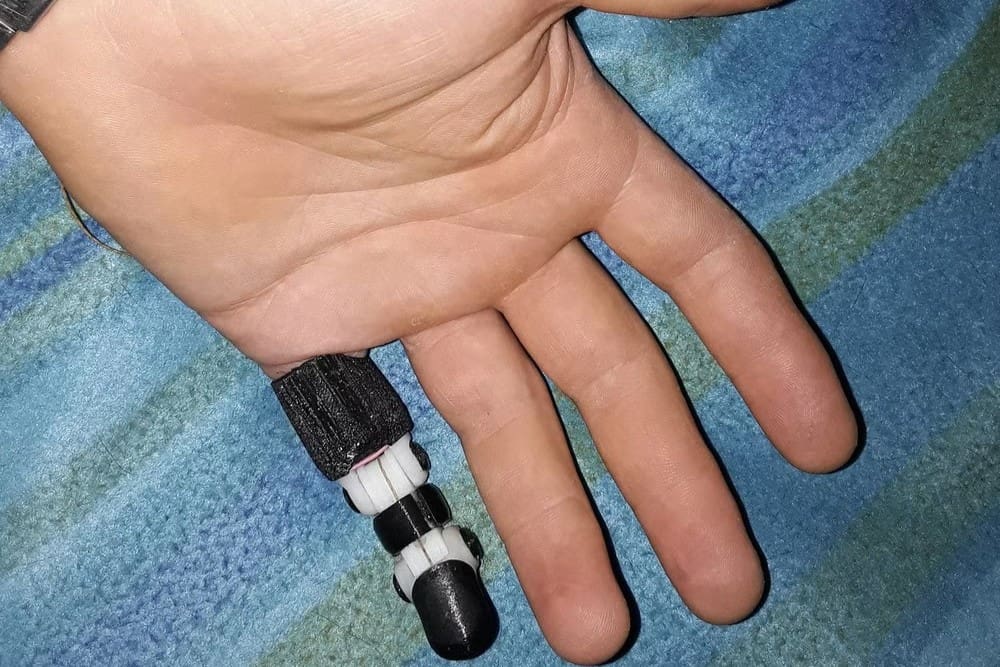
Prosthetic fingers are intended for people who have lost one or more fingers, partially or completely, but still have the palm of their hand. Similar to arms, prosthetic fingers are often made from silicone for cosmetic reasons (the material allows for highly realistic finishes).
Although it’s still in development, silicon also has the possibility to be used in printed functional fingers, as is the case of the Knick Finger. 3D printing reduces the cost of production and allows more detailed and complicated geometries, which are difficult to achieve by traditional manufacturing (like injection molding).
The Knick Finger, available through E-Nable, was designed by Nick Brookins and can be downloaded via Thingiverse. The model is simplistic and effective, and was designed to be used by people missing two finger segments. However, it can be customized for people missing only one (there are over 900 remixes). You can also adjust the size so it can comfortably fit its user. To that end, there’s a measurement guide, detailed instructions, and even a video to help you.
Depending on the piece you’re printing, you’ll want to use a harder material like PLA or flexible filament like NinjaFlex. You’ll also need some non-printable items, including fishing line and elastic cord.
- Materials: PLA, TPU (NinjaFlex)
- Printing technology: FDM
- Designed by: Nick Brookins
- Cost: Free
Knee
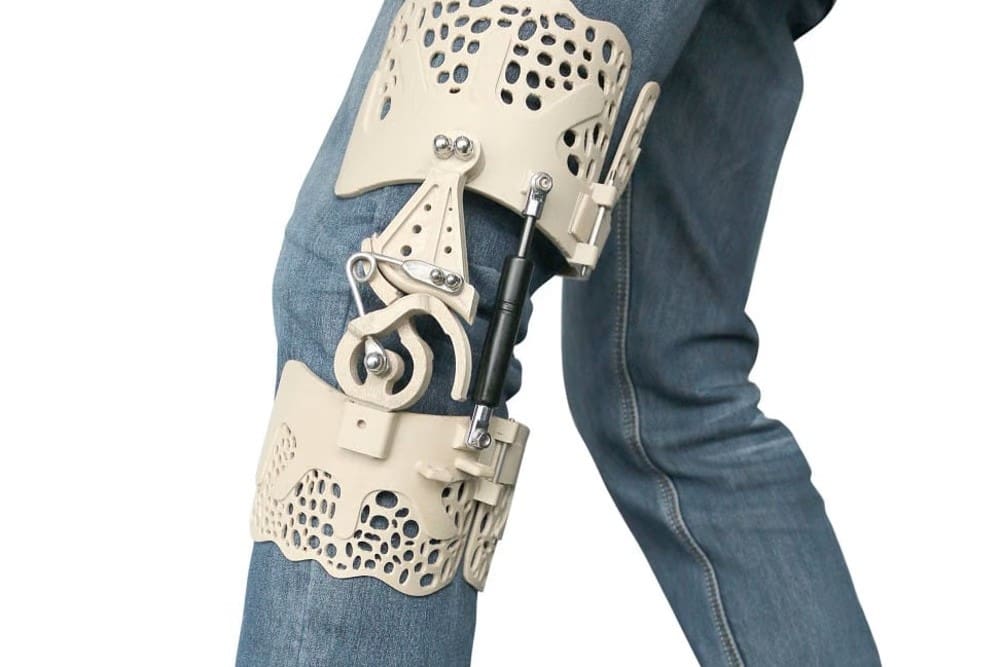
The knee is one of the hinges in the human anatomy with the most wear and shortest usage expectancy. This pioneer knee brace, called the BioNeek, is an ultra-light exoskeleton that helps support the weight of the knee for anyone with a compromised knee.
It was developed by the Chinese company Sichuan Ju An Hui Co. Ltd and 3D printed using PEEK, a popular filament in the medical field due to its unique properties. The brace is designed to absorb impact and prevent hyperextension of the knee. Padding on the inside ensures comfort.
- Material: PEEK
- Printing technology: FDM
- Designed by: Sichuan Ju An Hui Co. Ltd
- Cost: Not specified
Facial

A Brazilian cancer survivor, Denise Vicentin, received a face transplant from a facial prosthesis made with 3D printing. The complete details of this cutting-edge technology can be found in an article published in the Journal of Otolaryngology. The technique has been in development since 2016, and finally, at the end of 2019, the researchers were able to try it out on Ms. Vicentin, who had lost her right eye and part of her jaw to cancer.
The process consisted of first scanning the patient’s face through different photogrammetry methods available via smartphone. Then, after many tests and surgeries to prepare the face for the prosthesis, the final prosthetic was printed in 12 hours and painted to match Denise’s skin.
This successful study has led the researchers to look into opening a specialized lab for facial rehabilitation through 3D printing.
- Material: Duraform polyamide C15
- Printing technology: SLS
- Designed by: Paulista University
- Cost: Not specified
License: The text of "The Most Common 3D Printed Prosthetics" by All3DP is licensed under a Creative Commons Attribution 4.0 International License.

